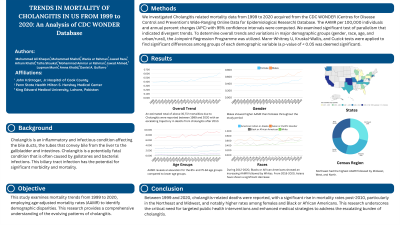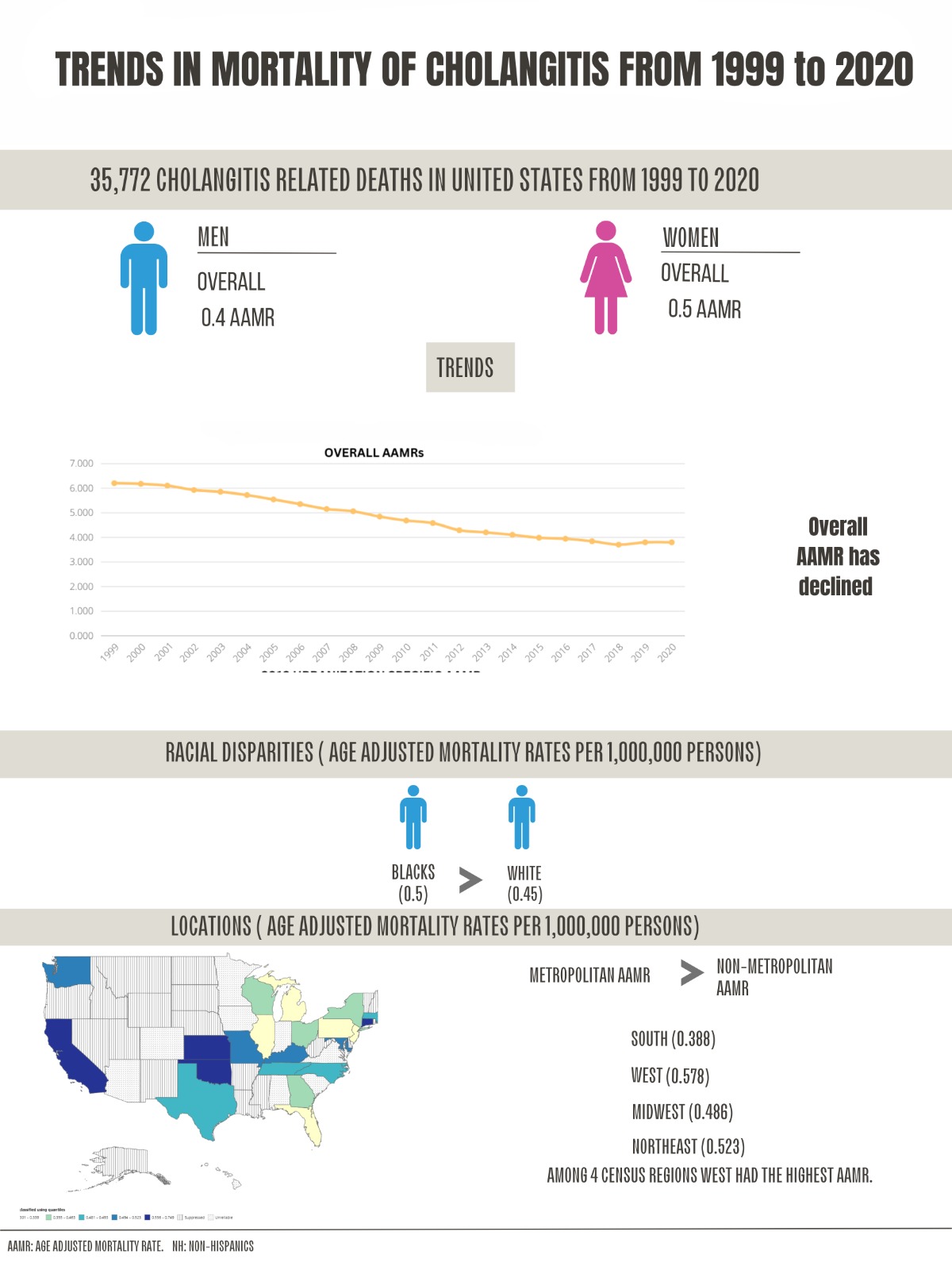Sunday Poster Session
Category: Biliary/Pancreas
P0061 - Trends in Mortality of Cholangitis From 1999 to 2020: An Analysis of CDC WONDER Database
Sunday, October 27, 2024
3:30 PM - 7:00 PM ET
Location: Exhibit Hall E

Has Audio
- MK
Muhammad Ali Khaqan, MD
John H. Stroger, Jr. Hospital of Cook County
Lexington, KY
Presenting Author(s)
Muhammad Ali Khaqan, MD1, Muhammad Shahzil, MD2, Wania Rehman, MBBS3, Jawad Raza, MBBS3, Arham Khalid, MBBS3, Taha Shaukat, MBBS3, Muhammad Ammar Ur Rahman, MBBS3, Jawad Ahmed, MBBS3, Luqman Munir, MBBS3, Amna Khalid, MBBS3, Daniel A. Guifarro, MD1
1John H. Stroger, Jr. Hospital of Cook County, Chicago, IL; 2Penn State Health Milton S. Hershey Medical Center, Hershey, PA; 3King Edward Medical University, Lahore, Punjab, Pakistan
Introduction: Cholangitis is an inflammatory and infectious condition affecting the bile ducts, the tubes that convey bile from the liver to the gallbladder and intestines. Cholangitis is a potentially fatal condition that is often caused by gallstones and bacterial infections. This biliary tract infection has the potential for significant morbidity and mortality.
In the United States, cholangitis mortality has significantly increased since 2010. This study examines mortality trends from 1999 to 2020, employing age-adjusted mortality rates (AAMR) to identify demographic disparities. By systematically analyzing trends over the past decades, this research provides a comprehensive understanding of the evolving patterns of cholangitis.
Methods: We investigated cholangitis-related mortality data from 1999 to 2020 acquired from the CDC WONDER (Centers for Disease Control and Prevention's Wide-Ranging Online Data for Epidemiological Research) Database. The AAMR per 100,000 individuals and annual percent changes (APC) with 95% confidence intervals were computed. We performed significant tests of parallelism that indicated divergent trends. To determine overall trends and variations in major demographic groups (gender, race, age, and urban/rural), the Joinpoint Regression Program was utilized.
Results: An estimated total of 35,772 mortalities due to Cholangitis were reported between 1999 and 2020. Analysis revealed an escalating trajectory in deaths from cholangitis after 2010. Initially, a declining trend in AAMR was noted from 1999 to 2010, with an APC of 0.5, followed by a sharp rise in APC to 3.5 from 2010 to 2020. Statistics showed an increased death toll in the Northeast and Midwest with subsequently high mortality in the latter in recent years. Females presented elevated mortality rates over the years in contrast to males. The AAMR itself has increased from 2010 to 2020. Higher mortality rates were noted in Black or African Americans.
Discussion: Between 1999 and 2020, cholangitis-related deaths were reported, with a significant rise in mortality rates post-2010, particularly in the Northeast and Midwest, and notably higher rates among females and Black or African Americans. This research underscores the critical need for targeted public health interventions and enhanced medical strategies to address the escalating burden of cholangitis.

Disclosures:
Muhammad Ali Khaqan, MD1, Muhammad Shahzil, MD2, Wania Rehman, MBBS3, Jawad Raza, MBBS3, Arham Khalid, MBBS3, Taha Shaukat, MBBS3, Muhammad Ammar Ur Rahman, MBBS3, Jawad Ahmed, MBBS3, Luqman Munir, MBBS3, Amna Khalid, MBBS3, Daniel A. Guifarro, MD1. P0061 - Trends in Mortality of Cholangitis From 1999 to 2020: An Analysis of CDC WONDER Database, ACG 2024 Annual Scientific Meeting Abstracts. Philadelphia, PA: American College of Gastroenterology.
1John H. Stroger, Jr. Hospital of Cook County, Chicago, IL; 2Penn State Health Milton S. Hershey Medical Center, Hershey, PA; 3King Edward Medical University, Lahore, Punjab, Pakistan
Introduction: Cholangitis is an inflammatory and infectious condition affecting the bile ducts, the tubes that convey bile from the liver to the gallbladder and intestines. Cholangitis is a potentially fatal condition that is often caused by gallstones and bacterial infections. This biliary tract infection has the potential for significant morbidity and mortality.
In the United States, cholangitis mortality has significantly increased since 2010. This study examines mortality trends from 1999 to 2020, employing age-adjusted mortality rates (AAMR) to identify demographic disparities. By systematically analyzing trends over the past decades, this research provides a comprehensive understanding of the evolving patterns of cholangitis.
Methods: We investigated cholangitis-related mortality data from 1999 to 2020 acquired from the CDC WONDER (Centers for Disease Control and Prevention's Wide-Ranging Online Data for Epidemiological Research) Database. The AAMR per 100,000 individuals and annual percent changes (APC) with 95% confidence intervals were computed. We performed significant tests of parallelism that indicated divergent trends. To determine overall trends and variations in major demographic groups (gender, race, age, and urban/rural), the Joinpoint Regression Program was utilized.
Results: An estimated total of 35,772 mortalities due to Cholangitis were reported between 1999 and 2020. Analysis revealed an escalating trajectory in deaths from cholangitis after 2010. Initially, a declining trend in AAMR was noted from 1999 to 2010, with an APC of 0.5, followed by a sharp rise in APC to 3.5 from 2010 to 2020. Statistics showed an increased death toll in the Northeast and Midwest with subsequently high mortality in the latter in recent years. Females presented elevated mortality rates over the years in contrast to males. The AAMR itself has increased from 2010 to 2020. Higher mortality rates were noted in Black or African Americans.
Discussion: Between 1999 and 2020, cholangitis-related deaths were reported, with a significant rise in mortality rates post-2010, particularly in the Northeast and Midwest, and notably higher rates among females and Black or African Americans. This research underscores the critical need for targeted public health interventions and enhanced medical strategies to address the escalating burden of cholangitis.

Figure: Trends in Mortality of Cholangitis from 1999 to 2020: An Analysis of CDC WONDER Database
Disclosures:
Muhammad Ali Khaqan indicated no relevant financial relationships.
Muhammad Shahzil indicated no relevant financial relationships.
Wania Rehman indicated no relevant financial relationships.
Jawad Raza indicated no relevant financial relationships.
Arham Khalid indicated no relevant financial relationships.
Taha Shaukat indicated no relevant financial relationships.
Muhammad Ammar Ur Rahman indicated no relevant financial relationships.
Jawad Ahmed indicated no relevant financial relationships.
Luqman Munir indicated no relevant financial relationships.
Amna Khalid indicated no relevant financial relationships.
Daniel Guifarro indicated no relevant financial relationships.
Muhammad Ali Khaqan, MD1, Muhammad Shahzil, MD2, Wania Rehman, MBBS3, Jawad Raza, MBBS3, Arham Khalid, MBBS3, Taha Shaukat, MBBS3, Muhammad Ammar Ur Rahman, MBBS3, Jawad Ahmed, MBBS3, Luqman Munir, MBBS3, Amna Khalid, MBBS3, Daniel A. Guifarro, MD1. P0061 - Trends in Mortality of Cholangitis From 1999 to 2020: An Analysis of CDC WONDER Database, ACG 2024 Annual Scientific Meeting Abstracts. Philadelphia, PA: American College of Gastroenterology.
